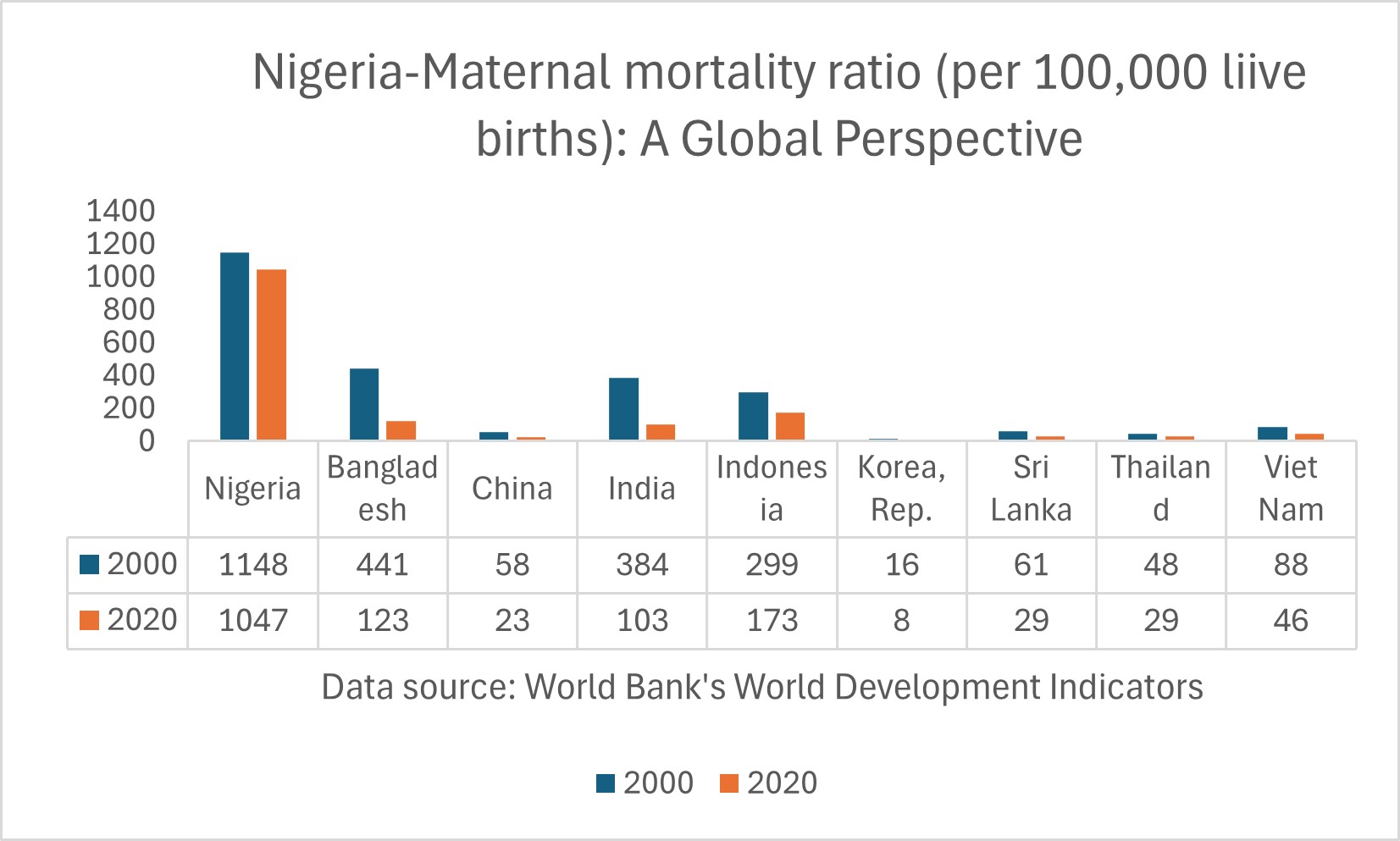
Nigeria
Country Flag Details
three equal vertical bands of green (hoist side), white, and green; the color green represents the forests and abundant natural wealth of the country, white stands for peace and unity
Background
Africa’s most populous country attained independence from Britain in 1960. Adoption of a new constitution in 1999 completed a peaceful transition to civilian rule. The government continues to face the daunting task of institutionalizing democracy and reforming a petroleum-based economy despite widespread corruption and crime.
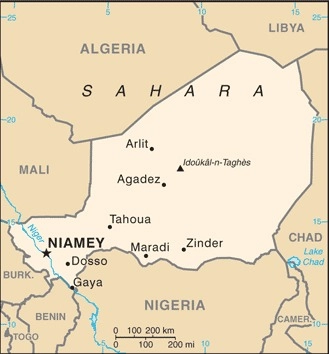
Gegraphy
Area
total : 923,768 sq km
land: 910,768 sq km
water: 13,000 sq km
Climate
varies; equatorial in south, tropical in center, arid in north
Natural resources
natural gas, petroleum, tin, iron ore, coal, limestone, niobium, lead, zinc, arable land.
People and Society
Population
total: 236,747,130
Ethnic groups
Hausa 30%, Yoruba 15.5%, Igbo (Ibo) 15.2%, Fulani 6%, Tiv 2.4%, Kanuri/Beriberi 2.4%, Ibibio 1.8%, Ijaw/Izon 1.8%, other 24.9% (2018 est.)
Languages
English (official), Hausa, Yoruba, Igbo (Ibo), Fulani, over 500 additional indigenous languages
Religions
Muslim 53.5%, Roman Catholic 10.6%, other Christian 35.3%, other 0.6% (2018 est.)
Population growth rate
2.52% (2024 est.)
Government type
federal presidential republic
Capital name: Abuja
Executive branch
chief of state: President Bola Ahmed Adekunle TINUBU (since 29 May 2023)
head of government: President Bola Ahmed Adekunle TINUBU (since 29 May 2023)
Economy
Real GDP (purchasing power parity)
$1.275 trillion (2023 est.)
$1.239 trillion (2022 est.)
$1.2 trillion (2021 est.)
Real GDP per capita
$5,600 (2023 est.)
$5,600 (2022 est.)
$5,500 (2021 est.)
Exports
$60.261 billion (2023 est.)
$69.091 billion (2022 est.)
$50.856 billion (2021 est.)
Exports – partners
USA 10%, Spain 9%, France 8%, Netherlands 7%, India 6% (2023)
Exports – commodities
crude petroleum, natural gas, gold, fertilizers, cocoa beans (2023)
Imports
$65.423 billion (2023 est.)
$77.049 billion (2022 est.)
$67.478 billion (2021 est.)
Imports – partners
China 26%, Singapore 14%, Belgium 8%, India 6%, USA 4% (2023)
Imports – commodities
refined petroleum, tanks and armored vehicles, wheat, plastics, cars (2023)

Export structure by product group in 2023 (% of total export) (UNCTAD)
The export structure of a country encompasses the variety, composition, and value of its goods and services traded internationally, offering crucial insights into the nation’s economic vitality, competitiveness, and stage of development. The dominance of oil and gas in Nigeria’s export profile underscores the economy’s vulnerability to fluctuations in global energy prices. As a result, there are ongoing initiatives aimed at broadening the export base to include more non-oil products, thereby enhancing economic resilience.
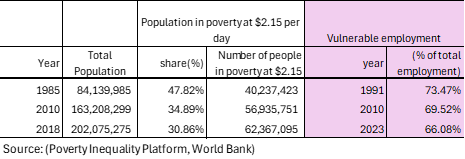
Poverty and vulnerable employment in Nigeria (World Bank)
Vulnerable employment encompasses jobs that are marked by insufficient job security, meager wages, and a significant absence of social protections such as health insurance, pensions, or labor rights. This category predominantly includes own-account workers, who are individuals operating independently without any employees, like street vendors and small-scale farmers, as well as contributing family workers, who assist in family-owned businesses or farms without receiving any formal financial compensation. This type of employment leaves many individuals and families at risk, struggling to make ends meet in an environment that offers little stability or support, reflecting the challenges faced by countless workers in Nigeria and similar contexts.
Understanding poverty level significance at $2.15
The poverty level at $2.15 per day (measured in 2017 purchasing power parity, or PPP) is a key global benchmark used by the World Bank to define extreme poverty in low-income countries. It indicates:
1. Basic Survival Threshold
• People living below $2.15 per day struggle to afford essential needs such as food, clean water, shelter, healthcare, and education.
2. Economic Underdevelopment
• A high percentage of a country’s population living below this threshold suggests low economic productivity, high unemployment, and weak social safety nets.
3. Inequality and Social Vulnerability
• It reflects deep income inequality and a lack of access to opportunities for upward mobility.
• People in this category are more vulnerable to shocks like food price increases, climate disasters, or health crises.
4. Policy Challenges
• Governments need targeted interventions such as social welfare programs, job creation, and improved access to education and healthcare to reduce poverty.
A country's export structure is a reflection of its level of development and productive capacities
The export structure of a country refers to the composition, diversity, and value of the goods and services it sells to other countries. It provides key insights into the country’s economic health, competitiveness, and level of development. Productive capacities of a country refer to its ability to produce goods and services efficiently and sustainably over time. These capacities are shaped by various factors, including human capital, natural resources, infrastructure, private sector, development, technology & innovation, institutions & governance, financial systems trade & market access.
Here’s what the export structure and productive capacities of a country typically indicate:
- Level of Economic Development
- Developed economies usually export high-value manufactured goods, technology, and services.
- Developing economies often rely on raw materials, agricultural products, or low-value manufactured goods.
- Industrial and Sectoral Strengths
- A strong presence of high-tech or industrial goods (e.g., machinery, electronics) suggests a well-developed manufacturing sector.
- A dominance of commodities (e.g., oil, minerals, agricultural products) indicates reliance on natural resources.
- Export Diversification
- A diverse export base (multiple industries) makes a country’s economy more stable and resilient to global price shocks.
- A concentrated export base (few key products) makes it vulnerable to market fluctuations.
- Trade Partnerships and Dependence
- If exports are heavily dependent on a single country or region, the economy is more exposed to geopolitical and trade risks.
- A wide range of trading partners indicates stronger global integration.
- Competitiveness and Value Addition
- Exporting mainly raw materials (e.g., crude oil instead of refined petroleum) suggests limited industrial processing capacity.
- A high share of finished and high-tech goods suggests strong value addition and competitiveness.
Nigeria-Sanitation
Nigeria- Proportion of population served with at least basic sanitation
In 2022, proportion of population served with at least basic sanitation for Nigeria was 46.6 %. Between 2000 and 2022, proportion of population served with at least basic sanitation of Nigeria grew substantially from 28% in 2000 to 46.6 % in 2022, an absolute change of 18.6 percentage points (pp) between 2000 and 2022.
Nigeria – Proportion of urban population served with at least basic sanitation
In 2022, proportion of urban population served with at least basic sanitation for Nigeria was 57.6 %. Proportion of urban population served with at least basic sanitation of Nigeria increased from 28.3 % in 2000 to 57.6 % in 2022, an absolute change of 29.3pp between 2000 and 2022.
Nigeria – Proportion of rural population served with at least basic sanitation
In 2022, proportion of rural population served with at least basic sanitation for Nigeria was 33.9 %. Proportion of rural population served with at least basic sanitation of Nigeria increased from 27.8 % in 2003 to 33.9 % in 2022, an absolute change of 6.1 pp between 2000 and 2022.
Nigeria- Proportion of total population served with at least basic sanitation: A Global Perspective
Nigeria’s sanitation crisis affects millions and calls for immediate action as it contributes to preventable deaths and represents a severe public health emergency. Access to safe sanitation is a fundamental human right that must be guaranteed for all individuals. In 2022, 118 million people, nearly 53 percent of Nigeria’s population, experienced inadequate sanitation, revealing alarming disparities compared to other nations. For example, Vietnam, China, and Thailand reported only 8 percent, 5 percent, and 1 percent of their populations lacking basic services, while the global average stands at approximately 6 percent. This situation highlights the pressing need for unified efforts and strategic initiatives to enhance sanitation access in marginalized regions of Sub-Saharan Africa.
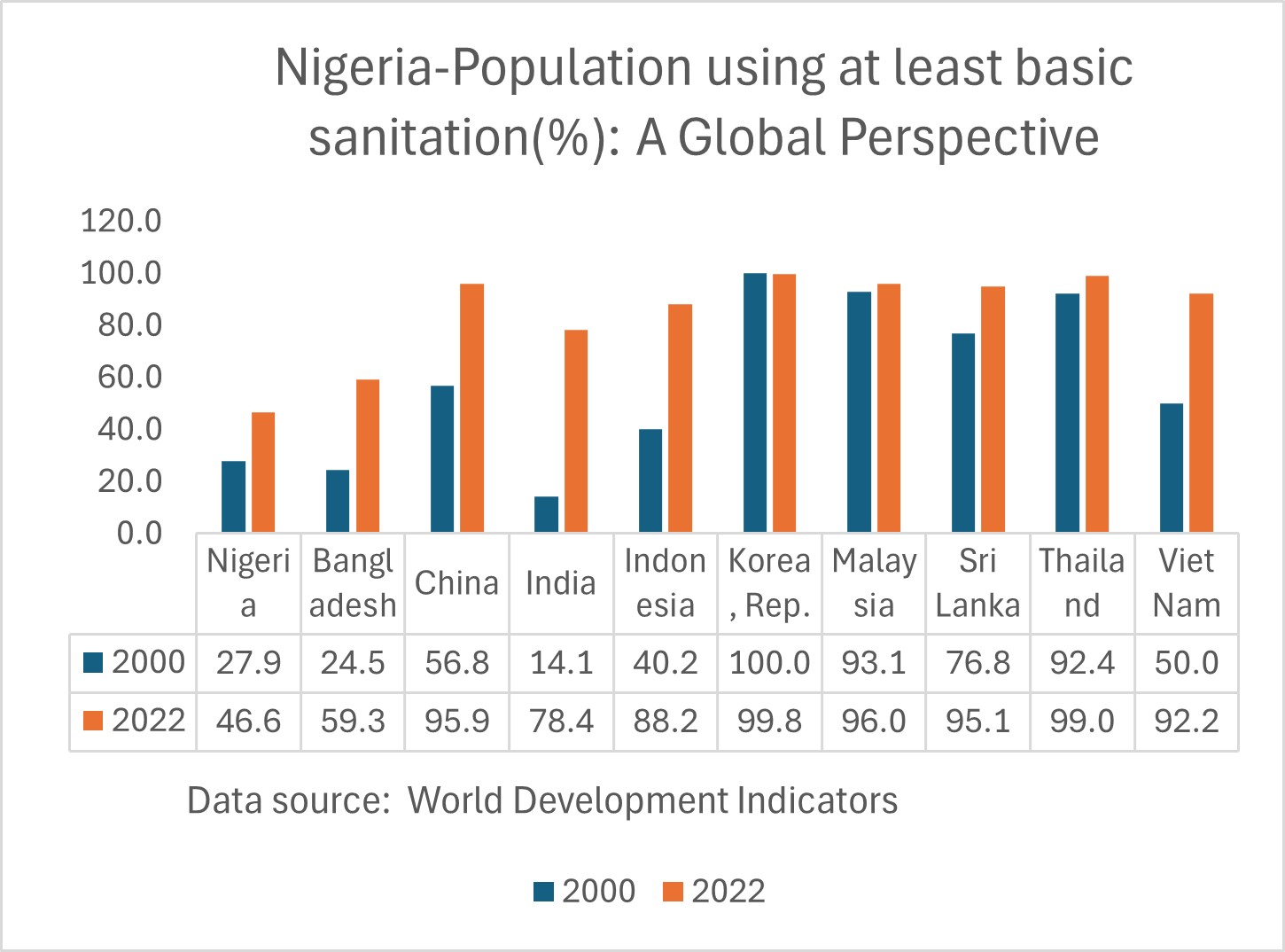
Nigeria- Proportion of rural population served with at least basic sanitation: A Global Perspective
In 2022, nearly 67 million individuals in the rural areas of Nigeria, representing approximately 66 percent of this population, faced the grim reality of living without access to basic sanitation facilities, revealing a stark disparity when compared to countries such as Vietnam, Sri Lanka, and Thailand, which reported significantly lower figures of just 12 percent, 5 percent, and 2 percent respectively. The lack of safe sanitation transcends mere urgency; it is a profound crisis that necessitates immediate and coordinated action, as it contributes to the preventable deaths of countless individuals each year, underscoring an urgent public health emergency that calls for swift and resolute intervention. Safe sanitation is not merely a fundamental necessity; it is an intrinsic human right that every individual deserves without exception. Thus, it is crucial that we unify our efforts to advocate for and advance this essential right across Sub-Saharan Africa, where the urgency is most acute, and the transformative impact on communities can be immense.
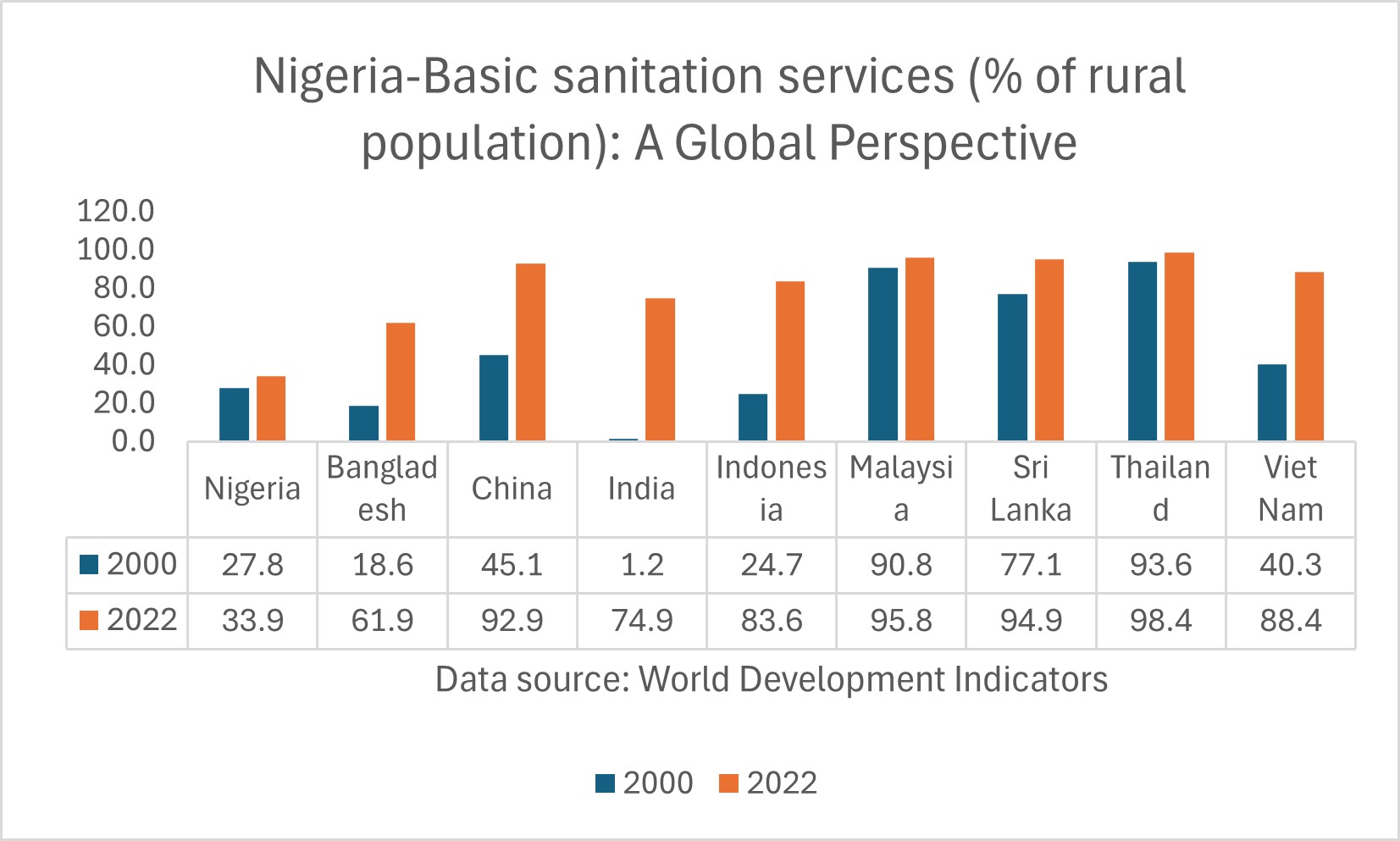
Nigeria-Water Supply
Nigeria – Proportion of total population served with at least basic water
In 2022, proportion of population served with at least basic water for Nigeria was 79.6 %. Proportion of population served with at least basic water of Nigeria increased from 44.4 % in 2003 to 79.6 % in 2022, an absolute change 35.2 pp between 2000 and 2022.
Nigeria – Proportion of urban population served with at least basic water
In 2022, proportion of urban population served with at least basic water for Nigeria was 93.7 %. Proportion of urban population served with at least basic water of Nigeria increased from 68.4 % in 2000 to 93.7 % in 2022 , an absolute change of 25.3 pp between 2000 and 2022.
Nigeria – Proportion of rural population with at least basic water
In 2022, proportion of rural population served with at least basic water for Nigeria was 63.5 %. Proportion of rural population served with at least basic water of Nigeria increased from 31.6 % in 2000 to 63.5 % in 2022 , an absolute change of 31.8 pp between 2000 and 2022.
Nigeria – Proportion of total population served with at least basic drinking water: A Global Perspective
Access to safe drinking water is a fundamental human right essential for health and well-being. In 2022, nearly 47 million people in Nigeria, about 20 percent of the population, lacked this vital resource, highlighting significant inequalities that many of us take for granted. In contrast, everyone in Thailand had access to safe drinking water, and 98 percent of individuals in both Bangladesh and Vietnam enjoyed this critical right, revealing sharp disparities globally. These injustices demand urgent, compassionate action to improve living conditions and ensure that vulnerable communities in Sub-Saharan Africa can access safe drinking water, as the repercussions of these inequalities are severe and require our immediate response to create a fairer and sustainable future for all.
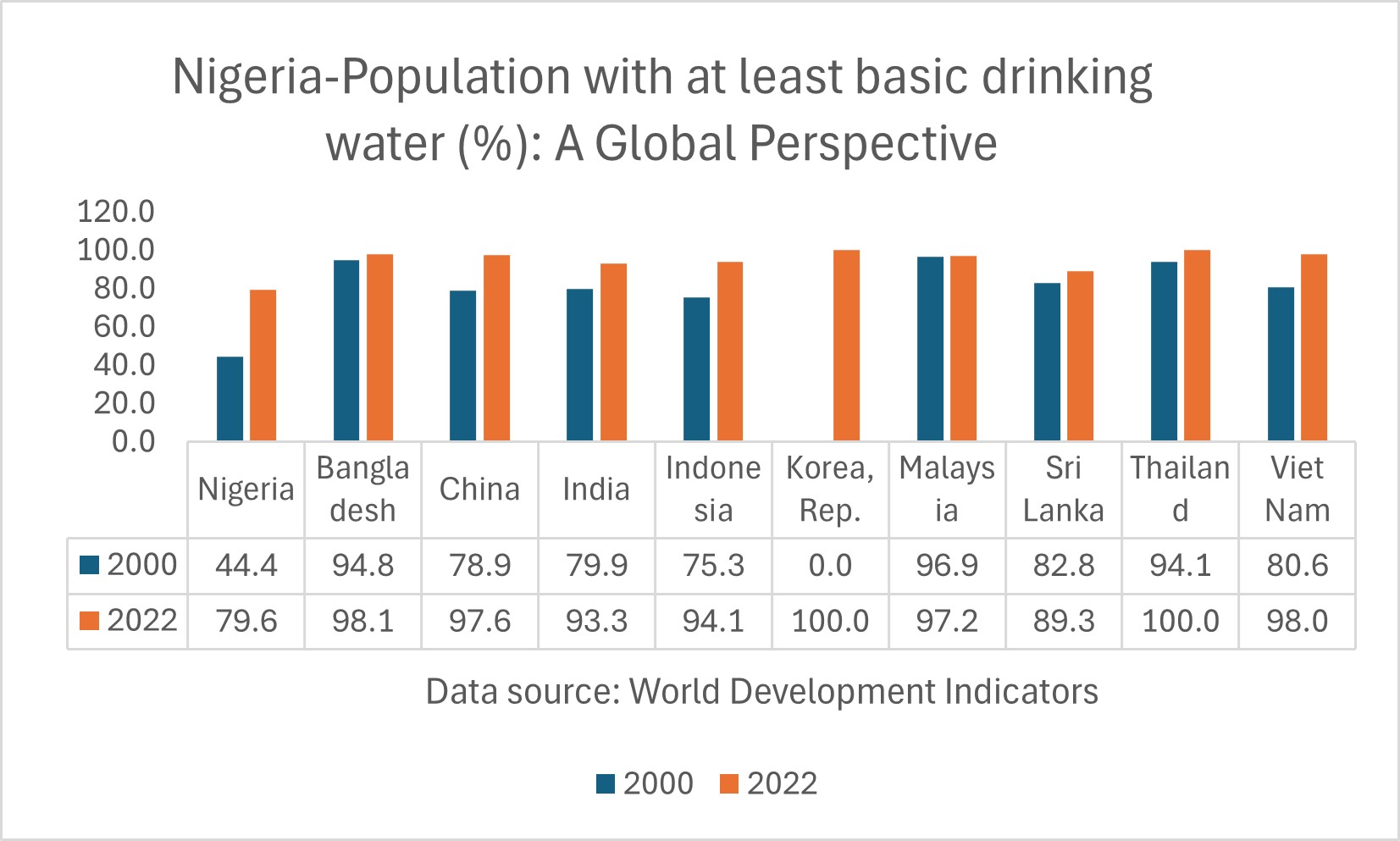
Nigeria – Proportion of rural population served with at least basic drinking water: A Global Perspective
In 2022, it was disheartening to discover that 36 percent of Nigeria’s rural population lacked access to basic drinking water facilities, affecting approximately 37 million individuals. In stark contrast, countries such as Thailand and Bangladesh achieved near-universal access for their rural residents with 100 percent and 98 percent respectively. This substantial disparity underscores the profound challenges faced by millions in Nigeria and emphasizes the urgent need for compassionate and transformative initiatives across Sub-Saharan Africa. It serves as a poignant reminder of the crucial work that lies ahead in tackling the vital issues of water accessibility and sustainability across Sub-Saharan Africa
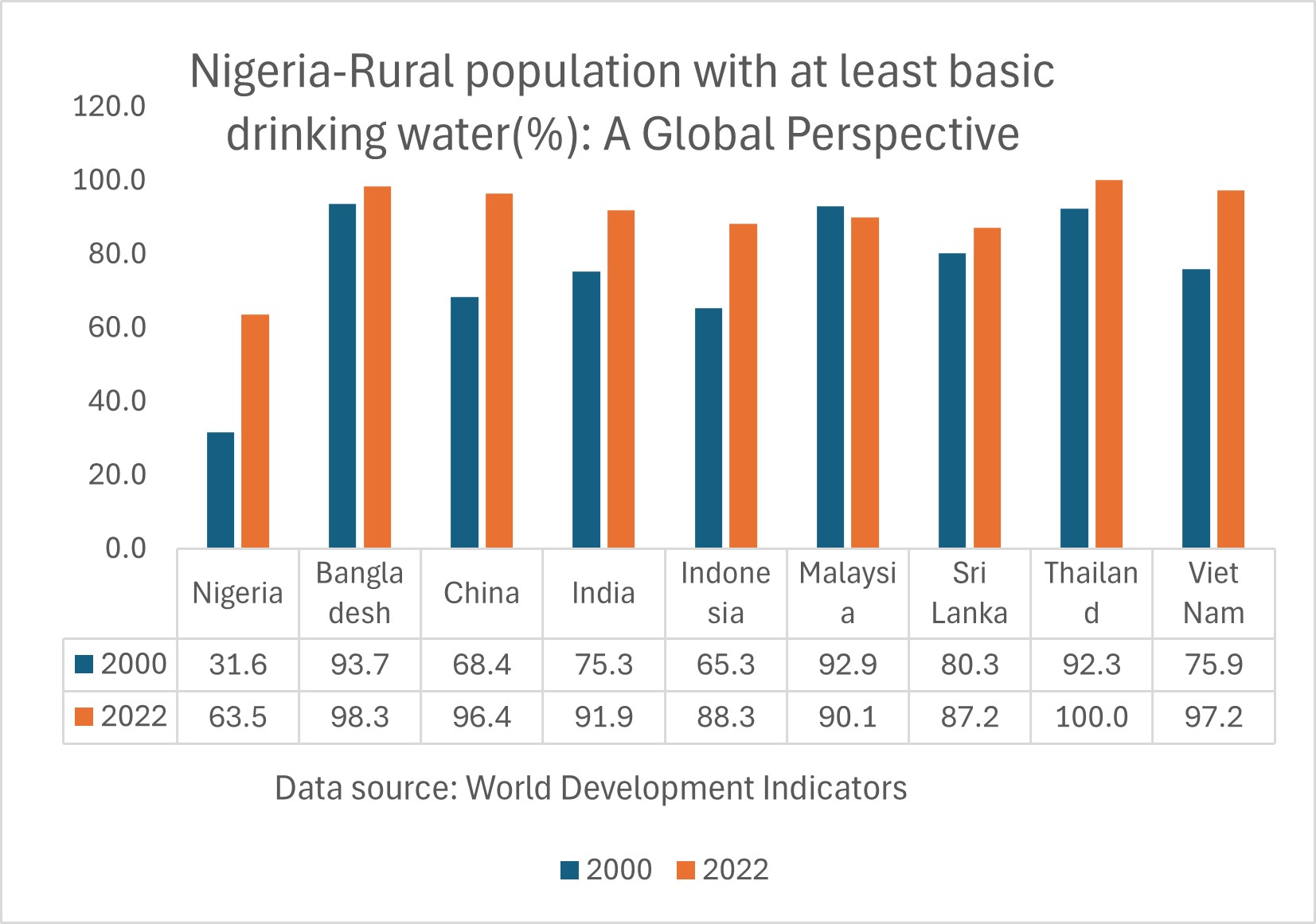
Nigeria-Access to Electricity
Nigeria-Access to electricity (% of population)
In 2022, proportion of population with access to electricity for Nigeria was 60.5 %. The proportion of population with access to electricity of Nigeria increased from 43.2% in 2000 to 60.5% in 2022, an absolute change of 17.3 pp between 2010 and 2022.
Nigeria-Access to electricity (% urban population)
In 2022, proportion of urban population with access to electricity for Nigeria was 89%. The proportion of urban population with access to electricity of Nigeria increased from 83.8% % in 2000 to 89% in 2022, an absolute change of 5.2pp between 2000 and 2022.
Nigeria-Access to electricity (% rural population)
In 2022, proportion of rural population with access to electricity for Nigeria was 27 %. The proportion of rural population with access to electricity of Nigeria increased from 21.5 % % in 2000 to 27% in 2022, an absolute change of 5.5pp between 2000 and 2025.
Nigeria – Proportion of total population with access to electricity: A Global Perspective
In 2022, nearly 39 percent of Nigeria’s population lacked access to electricity, impacting over 87 million people deprived of this essential service vital for daily living and economic activities. This situation highlights the urgent need for reform and the dire consequences for millions left in the dark, unable to power their homes, schools, and businesses. In contrast, countries like Vietnam, Thailand, Sri Lanka, and Malaysia have achieved universal electricity access through strategic investments and policy initiatives. It is essential for Sub-Saharan Africa to implement significant reforms to improve the quality of life and establish a foundation for equitable growth. Access to reliable electricity is crucial for development, health, education, and economic progress. Addressing this energy deficit can greatly enhance living standards and create a brighter future for all, benefiting both individuals and entire communities.
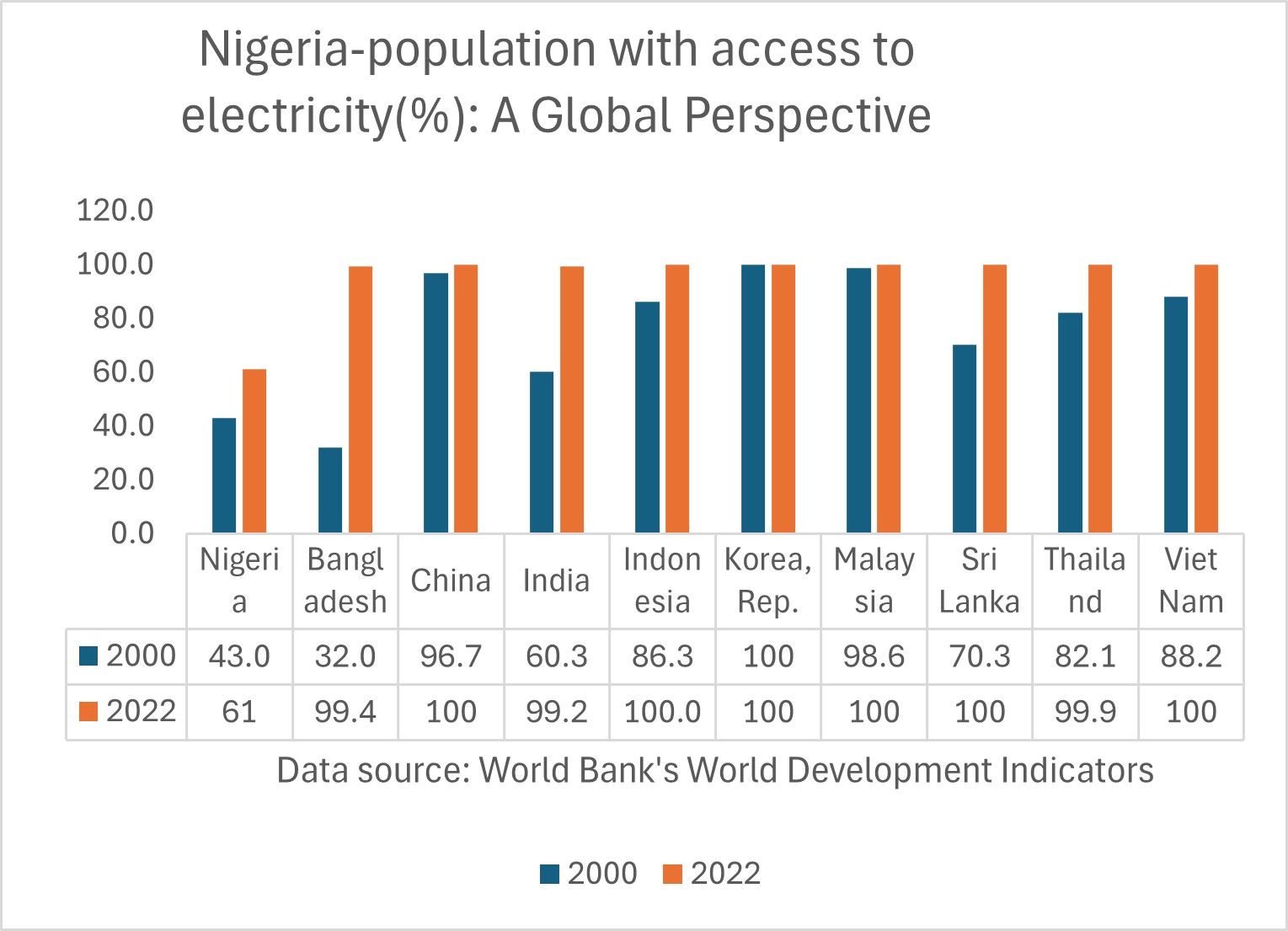
Nigeria – Proportion of rural population with access to electricity: A Global Perspective
In 2022, a staggering 73 percent of Nigeria’s rural population, approximately 75 million people, lived without electricity, starkly contrasting with countries like Vietnam, Thailand, and Sri Lanka, where all rural residents benefit from this essential resource. Meanwhile, India and Bangladesh have made remarkable strides, with 99 percent of their rural populations enjoying access to electricity, underscoring significant advancements in energy availability. These statistics highlight an urgent imperative for transformative governance reforms across Sub-Saharan Africa, ensuring that every community gains reliable electricity access and can effectively harness this vital resource. This is crucial for paving the way toward a sustainable, equitable, and resilient future, where all citizens can improve their quality of life, contribute to economic development, and foster social inclusion, leaving no one behind in the pursuit of progress and equity.

Nigeria- Health outcomes
Nigeria- Life-expectancy: A Global Perspective
The examination of life expectancy trends over the past seventy years highlights significant advancements in human longevity, yet stark disparities remain, particularly in Sub-Saharan Africa. While the global average life expectancy has increased from 47 years in 1950 to 71 years in 2021, many Sub-Saharan African countries show minimal improvements. For example, Nigeria’s life expectancy has only risen from 37 years in 1960 to 57 years in 2022, reflecting ongoing challenges. In contrast, countries like South Korea have seen life expectancy soar from 54 years in 1960 to 83 years in 2022, and the Maldives has grown from 39 years in 1960 to 81 years in 2022. The low life expectancy in many Sub-Saharan nations underscores the urgent issues they face, including poverty, underfunded healthcare, and governance challenges, necessitating immediate action to ensure equitable access to health and well-being for all communities.

Nigeria – Mortality rate, under-5 (per 1000 live births): A Global Perspective
Since 1950, child mortality rates have seen a significant global decline, primarily due to improvements in living standards, healthcare access, nutrition, and safe drinking water. In wealthy regions like Europe and North America, child mortality has dropped to less than four percent, showcasing the benefits of efficient healthcare systems and socioeconomic stability. While many developing countries have made progress over the past seventy years, Sub-Saharan Africa has lagged behind. For example, Nigeria’s under-five mortality rate fell from 213 in 1980 to 117 in 2022, whereas Bangladesh achieved a remarkable decline from 206 to 29, and India reduced its rate from 169 to 29 in the same period. These statistics reveal ongoing challenges from inadequate healthcare systems and highlight the pressing need for governance reforms in Sub-Saharan Africa to address child mortality and improve health outcomes.
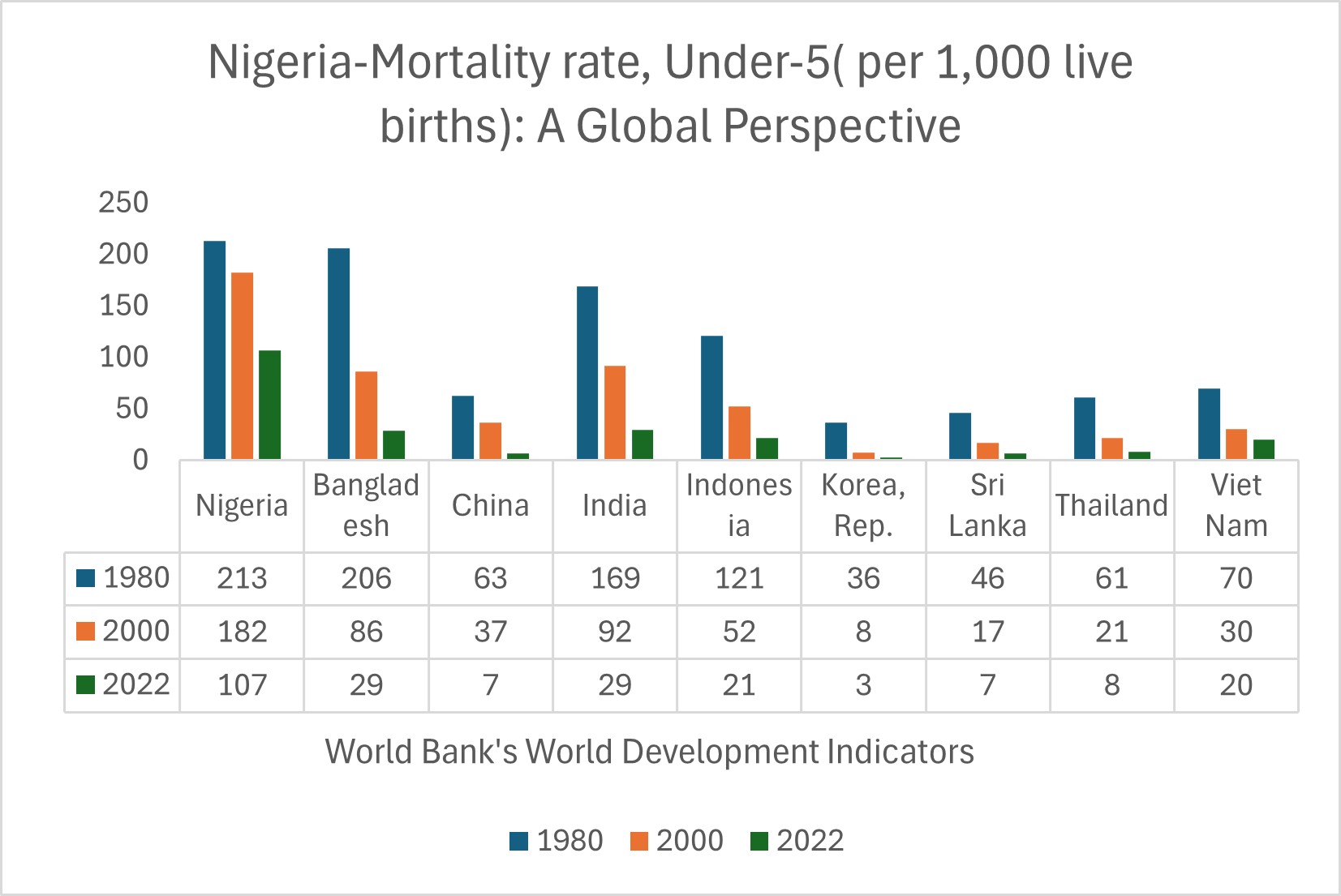
Nigeria – Maternal mortality ratio, (per 100,000 live births): A Global Perspective
Nigeria’s maternal mortality ratio presents a troubling situation, with a rate of 1148 deaths per 100,000 live births in 2000, only slightly decreasing to 1047 by 2020. This negligible improvement is particularly concerning when compared to the much lower rates of 123, 103, and 46 reported in Bangladesh, India, and Vietnam respectively in 2022. The alarming disparity highlights unacceptable pregnancy-related fatalities in Nigeria, worsened by a high birth rate and elevated maternal mortality rates. These distressing figures reveal significant deficiencies within the healthcare system and illustrate the chronic underfunding affecting health infrastructures across Sub-Saharan Africa. The urgent need for intervention is clear, as the lives of mothers and children in Nigeria remain at significant risk.
